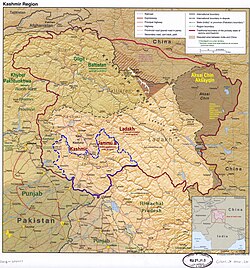Samba district | |
|---|---|
District of Jammu and Kashmir administered by India | |
 Village in Samba district | |
 Interactive map of Samba district | |
 Samba district is in the Jammu division (shown with neon blue boundary) of Indian-administered Jammu and Kashmir (shaded in tan in the disputed Kashmir region [1] | |
| Coordinates(Samba, Jammu and Kashmir): 32°34′N75°7′E / 32.567°N 75.117°E | |
| Administering country | India |
| Union Territory | Jammu and Kashmir |
| Division | Jammu Division |
| Headquarters | Samba, Jammu and Kashmir |
| Tehsils | Samba |
| Government | |
| • District Magistrate | Anuradha Gupta (KAS) |
| Area | |
• Total | 914 km2 (353 sq mi) |
| Population (2011) | |
• Total | 318,898 |
| • Density | 349/km2 (904/sq mi) |
| • Urban | 16.8% |
| Demographics | |
| • Literacy | 81.41% |
| • Sex ratio | 886 |
| Time zone | UTC+05:30 (IST) |
| Vehicle registration | JK-21 |
| Website | http://samba.nic.in/ |
Samba district is an administrative district in the Jammu division of Indian-administered Jammu and Kashmir in the disputed Kashmir region. [1] It was formed in 2006. [3] Before its formation, this area was part of Jammu district and Kathua district.